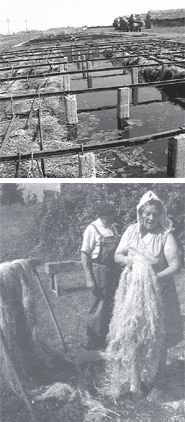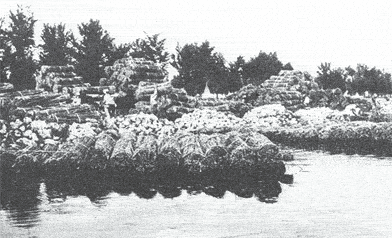


At the beginning of the 1900’s Italy was second in the World after Russia in the quantity of fibre hemp it produced. At the time over 100 000 ha were given over for its cultivation, with an annual yield in excess of 80 000 tonnes. In 1914 the province of Ferrara produced 363 000 tonnes, the province of Caserta 15 700, the province of Bologna 14 500 and the province of Napoli 8 900 tonnes. In the following years there was a continued reduction in the surface area cultivated and thus in the quantity of fibre produced. The economical crisis in hemp began in 1958 when it stopped being grown in the Padana Valley, and the crisis reached its conclusion in 1964 when the last attempts of the region of Campania to fight the inevitable recession failed, and it was forced to give in. Confronted with recession the large farmers soon moved on to produce other crops, and the industrial sector did not hesitate to adapt their plants, rendering the suitable for processing other fibre crops that came onto the market. The hand-labourers (particularly the more elderly ones), the craftsmen and the specialist weavers suffered from the recession though, seeing the little profit that had made vanish into nothing. It was infact since 1929 that more or less in all the world there was “the big crisis” that caused tremendous worry in the financial world. The most cautious nations had immediately adopted protective measures against the crisis, but in Italy this happened only in 1933 when Provinicial consortiums were created to defend the hemp production chain. Twenty years later these provincial consortiums merged into the National Consortium of Hemp Producers. No results had the large demonstrations of hemp growers, like that held in Caserta on 12th December 1946, and scientific conventions at a high level, nor was there any effect from the actions of the OMCE that encouraging to improve and incentivate the production of hemp and flax created the European Confederation of Flax and Hemp. In the same way the passionate debate on the crisis of hemp cultivation held on 12 Aug. 1952 with the participation of all the members of the parliament of the province also served nothing. No benefit was brought by the convention of Ferrara of 29-30 January 1955. At that time there was a clear unwillingness of the government to intervene, despite the fact that several political movements were urging them to do so. And so it followed that hemp cultivation was abandoned, and synthetic, resistant and cheap fibres became readily available and soon in use in the nautical field. Other sectors turned to using cotton, that by then has a much advanced mechanical system of harvesting processing. Among the causes that led to the crisis in hemp cultivation, one of the most significant was the way in which hemp fibre was produced. Per hectare 1200 hours of hand labour were needed – one of the highest inputs needed for any crop. Although on this can be seen as having employed around 30 000 workers, it offered them difficult working conditions, particularly during the phase of retting the stem bundles in pools of water. Some years later in the 60’s there was a mass abandoning of farms and countryside, and with it was lost the knowledge and the means that could enable hemp processing to continue. In addition, by this time the new synthetic fibres had almost entirely replaced hemp in even the most traditional yarns. Because of this an annual competition to design machinery for hemp cultivation began. The machines should have automated the various phases of hemp fibre production from cultivation to the finished textile. The design of the “retting-scutching plant” represents the last attempt to re-launch hemp cultivation in the area of Bologna. This machine was never made. Regardless, its initiative was to shift the labour-intensive retting process from the field to a factory, but not only this. The order of the processing was to change. It was intended that fresh green stems would be scutched on the farm, and the industrial retting process to obtain the fibre would be done afterwards. This approach would have enabled a better control over the delicate process of retting. Regardless of these aspects this and other projects were never started because the market for hemp had since collapsed. From then on hemp became an ever more distant memory of Italian farmers, until it was finally lost among the ever more widespread use of new processing technologies, sophisticated farm machinery and the gradually changing and genetically improving crops. And not only was the memory of hemp lost, with it went the knowledge on how to grow it as an industrial crop. In addition, the hackling machines were left to rust and the wonderful varieties of Italian hemp, once considered the best in world, vanished. All-in-all, the means that would permit anyone to successfully produce hemp fibre were gone. Add to this a blind legislation that likened fibre hemp varieties to drug varieties, and hemp cultivation has become essentially impossible. This situation continued until the second half of the 90’s when things seemed to change; there was a renewed interest that put hemp on the up-turn. Traditional fibre hemp had found new admirers – eco friendly movements. They put hemp in a new light as a natural crop with a low environmental impact that does not require herbicides and pesticides etc. and that has the capacity to rid the soil the weeds, thus having a positive effect in the soil in which it grows. These characters made hemp an ideal candidate as a non-food crop: This sector otherwise had a range of heavily pursued and not very sustainable crops, and crop diversification was being sought. In 1998 hemp cultivation recommenced on 255 hectares thanks to EEC contributions (?1 300 000 lire per hectare). In 1999 the area sown has reduced to 180 ha and in the year 2000 little more that 150 ha were grown. The subsidies of 1998 had not been sufficient to re-launch hemp cultivation in Italy because of the practicality of some laws regarding drugs. One of these laws, D.P.R no.309 dated 9.10.1990, had made farmers fearful of being prosecuted even if they were in keeping with the law. Then in 2001 the EC regulation no.2860/2000 was launched with force. This regulation set a new limit on the THC content at 0.2% (formerly 0.3%). Since drug varieties of hemp often have more that 10% THC this new limit of 0.2% seemed to take the control of the THC to an extreme. With respect to fibre hemp the only apparent effect that this new EC regulation had was to exclude Hungarian hemp varieties from market because they slightly exceeded the new limit. An additional factor that hindered the re-launch of hemp was the absence of known users from the list of raw material processors, something that would otherwise have enabled growers to sell their harvest at a good price in a short time. Furthermore, there was a misdemeanour with the list of varieties that if sown would permit EC subsidies to be obtained. For the only three Italian varieties included on the list there were no seeds available. Farmers were thus forced to obtain seeds from abroad, trusting in sometimes unfavourable contracts. Seed availability was problematic for an additional three reasons:
Despite the obstacles, progress has been, and the current situation is that a hackling plant has been built in Comacchio (in the province of Ferrara), and this is in addition to that it Guastalla that has already been operating for some time. In 2003, thanks to contracts guaranteeing purchase of the hemp, around 1000 ha of hemp have been, the majority of it in Emilia-Romagna. Moreover, a pilot project on the retting and hackling of hemp called TOSCANAPA is underway. This project intends to enable businesses and researchers to work together to build innovative processing plants and to then transfer the knowledge gained to an industrial scale. At the present day there is also a regional law in act in Tuscany (no.12/2002) that is the first of its kind, foreseeing the financial support of a pilot project on the entire production chain as well as offering other forms of support to start up the agro-industrial hemp fibre processing system. |


|
|
| Home | Company | Agricolture
| Industry | Hemp Crop |
Research | Link
| News e Downloads | Italiano Copyright © 2001
- Gruppo Fibranova S.r.l. - Via Antonio Gramsci n° 52 int. 18 - 56031 - Bientina (PI) Italia |